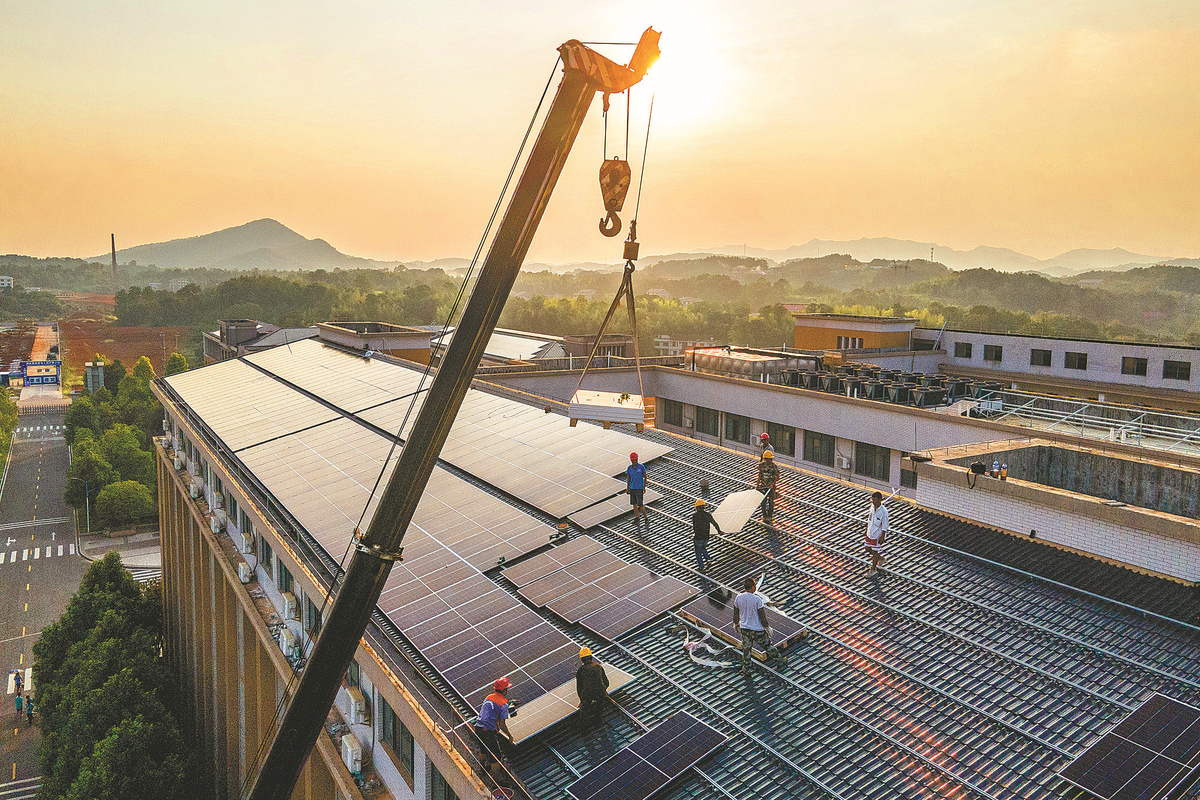A crane is used to lift solar panels onto the roof of a building at the No 1 Middle School in Shuangfeng county, Hunan province, on Aug 18. CHINA DAILY
Editor's note: As protection of the planet's flora, fauna and resources becomes increasingly important, China Daily is publishing a series of stories to illustrate the country's commitment to safeguarding the natural world.
A photovoltaic plant installed on a rooftop is helping to secure the success of China's climate change goals. Tan Yingzi reports from Chongqing.
Despite being one of the places with the lowest amount of sunshine in the country per year, Chongqing is exploring innovative ways of using solar power.
Now, large spaces on the roofs of local factories are providing green solutions for the sustainable development of the city, an industrial powerhouse in southwestern China.
In April, Chang'an Auto, one of the country's leading carmakers, began operating the largest rooftop photovoltaic project in the city, with a total installed capacity of 37 megawatts.
The project, covering 300,000 square meters, makes use of spare roofs and carports to house PV modules in the factory area.
Over a 25-year operational period, the project's total power generation capacity is expected to reach 667 million kilowatt-hours, reducing the use of standard coal by 240,000 metric tons and lowering carbon dioxide emissions by 670,000 tons, according to the carmaker.
In recent decades, China has made concerted efforts to achieve the goals of the UN Framework Convention on Climate Change and the Paris Agreement. In September 2020, the country pledged to realize the goals of peaking carbon dioxide emissions before 2030 and achieving carbon neutrality before 2060.

An aerial photo shows an "Energy Cube" that was built with solar panels on top to provide convenience for residents of Nanjing, Jiangsu province. JI CHUNPENG/XINHUA
Raft of measures
As such, the authorities have rolled out a raft of measures to significantly move China's installed capacity of wind and solar power toward a low-carbon, secure and efficient energy mix.
In a national action plan, the government pledged to accelerate construction of large wind power and photovoltaic bases in deserts. In the meantime, it will encourage distributed PV power generation in villages and industrial parks, and on the roofs of buildings.
By 2025, half of all new public buildings will have solar power facilities on their roofs, it said.
To promote the development of distributed PV power generation, central and local governments have issued a series of supporting policies and plans.
The 14th Five-Year Plan for Energy Development in Chongqing (2021-25) said the city government will promote the construction of rooftop PV systems across the entire municipality. It will also accelerate the promotion and utilization of distributed PV systems on rooftops in industrial parks, economic development zones and public buildings.
By 2025, the proportion of installed capacity of clean energy in Chongqing is set to reach 50 percent of the city's total.
"Many people think that Chongqing is not an ideal place to develop photovoltaic energy due to its foggy weather," said Shen Zhenghua, president of Chongqing Hiten Energy, a leading manufacturer of PV equipment. "However, I believe that Chongqing has a huge potential to make use of solar power."

Workers install solar panels on the cube's roof. CHINA DAILY
Huge potential
Surrounded by the Yangtze and Jialing rivers, the mountainous city lies in a high humidity zone, with annual average relative humidity of 70 to 80 percent. It only sees sunshine once every three or four days all year around, making it one of the areas in China with the lowest amount of sunshine annually, especially in spring and winter.
Despite this, Shen said that the suitability of a PV power generation project in Chongqing cannot be determined solely by the two indicators of sunlight hours and light intensity. Instead, such a project must be considered in combination with the price of electricity generated via PV power, PV system costs and several other factors, he said.
Founded in 2005, Shen's company was one of the first in the country to develop PV systems in low-sunshine areas. So far, it has built 1,885 PV power stations.
As a key manufacturing base in China, Chongqing has a large amount of suitable space on factory rooftops, which can be used for installing PV systems, Shen said.
Source: By Tan Yingzi, chinadaily.com, Sep. 07, 2023 [https://www.chinadaily.com.cn/a/202309/07/WS64f91b9aa310d2dce4bb45eb.html]


